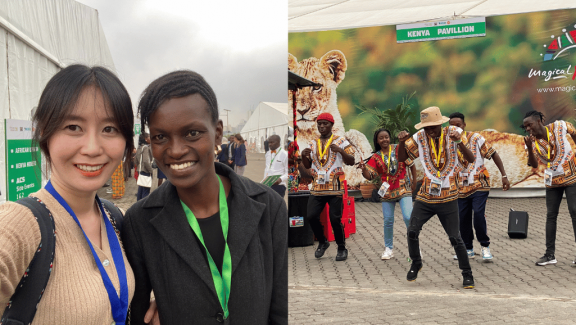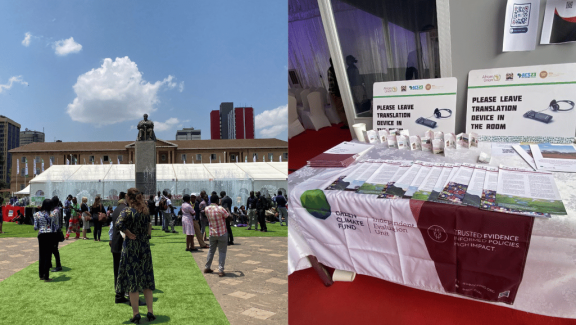“One printed brief can go a long way. Here is how.”
“The distribution of printed IEU evaluation briefs was a strategic communication approach during 2023 Africa Climate Week.”
Setting the scene: my experience with ‘paperless’ conferences
As a professional in climate change, it is quite common to observe that global conferences on climate change or sustainable development have become ‘paperless’ or near paperless. This trend is much needed and welcome, and the emphasis on paperless conferences and ways of doing things has also made me check my own daily ‘printing’ behaviour at work and elsewhere. It has helped me make a mental note and ask myself, ‘Is printing this report absolutely necessary?’ Such a critical assessment of the need has held me back from printing things profusely without thinking.
While attending some climate conferences or executive meetings in recent months, I was given a glare for bringing a few printed copies of evaluation reports, summaries, and briefs. The reason for the glare was due to the aspirations for more digitized and paperless conferences. As much as I support the idea of sustainable and responsible ways of consumption, which applies to printing as well, I do not think that the emphasis on being ‘paperless’ can be applied universally to all contexts, in a blanket manner. One printed brief can go a long way and make a difference in the lives of local and vulnerable communities and people – the very people that many international organizations, MDBs, and climate funds, like the Green Climate Fund, aim to better reach and support.
From 2 to 8 September, I attended the 2023 UNFCCC Africa Climate Week (ACW) and other technical meetings that took place in tandem with ACW in Nairobi, Kenya.[1] The very first technical conference that I attended in Nairobi was the 11th Conference on Climate Change and Development in Africa (#CCDA23). After the conclusion of the CCDA session on climate finance in Africa that I chaired and moderated, I interacted with the enthusiastic participants who lingered after the session. I shared with them the ‘few’ printed briefs and summaries of IEU evaluations of GCF’s investments in Africa and GCF’s overall performance in the 2020-2023 period.
Rather than going to the conference empty-handed and telling the diverse group of people that I am meeting for the very first time to go to the IEU website, I was able to quickly introduce myself and bring context to the IEU’s work by showing them the printed 2-page evaluation brief. If not for this 2-pager, I may have needed to say something like this: “Please go to ieu-dot-greenclimate-dot-fund.”; “No, no. Not eiu but ieu.”; “Do you have it yet?”; “If not, perhaps you can scan this QR code instead, which will lead you to the IEU website.”; “What? It doesn’t work? Can I see your phone for a second?”…
The value of one printed brief on climate finance for local communities
Nancy Marangu from Kenya, an advocate for indigenous peoples in climate action from the Chemichemi Foundation, was particularly delighted to receive the printed brief containing key findings from the IEU’s evaluation of GCF’s investments in Africa. Moreover, she inquired right at the conference venue, whether it would be fine with the IEU if she were to translate the content of this evaluation brief into Swahili or any other local languages spoken by the indigenous tribes of Kenya, such as the Turkana, Samburu, Borana, and Maasai, to make the information accessible for them. These tribes also tend to be nomadic, semi-nomadic, or pastoralist groups, which means they are remote and distanced from urban infrastructure including digital infrastructure by the nature of their way of living. The Chemichemi Foundation provides support for building the capacity of indigenous peoples, women, youth, and marginalized groups so that they can better adapt to and cope with the effects of climate change.[2] Nancy was thrilled that she could use the information contained in the IEU brief to raise the indigenous people’s awareness of climate finance in general and of various climate finance sources, including the GCF.
“The distribution of printed IEU evaluation briefs was a strategic communication approach during 2023 Africa Climate Week. These briefs contain a specific and tailored message useful to civil society organizations and NGOs – the sector I represent – and to other participants including policymakers, financial institutions, and businesses,” Nancy shared with me. Another benefit of having the printed brief is that she can keep it with her and refer back to it even after the conclusion of the conference. “Importantly, the IEU briefs can serve as a point of reference for us participating in the conference on any requisite information. The printed materials can also be shared with third parties and institutions who did not get to attend the conference themselves,” she added. Although it did not strike me right there and then, this aspect of being able to share the brief with others, including other colleagues in her line of work, was quite important even from the perspective of access to information and climate justice for the indigenous tribes and communities. Before access to finance, access to information about climate finance and its sources needs to precede, and the Chemichemi Foundation has been looking for the right kind of information materials as it is planning to organize information workshops for the indigenous communities, who are among the most adversely affected by climate change.
Accessible and inclusive channels of communication that work well in local and specific contexts
For those of us coming from a country or a region where a completely ‘digital’ way of doing things is not only possible but easy, it does make sense to come to any global conference with the expectation that we ourselves do not ‘need’ to pick up any printed materials necessarily. Yes, I don’t need to pick up any printed materials myself at a conference because I can easily find relevant information online about a certain speaker or a specific organization during or after the conference. Nowadays, we also like to simply provide a QR code that people can scan with their mobile phones to get access to our most prized reports and studies. However, for those who may be representing or working for particularly vulnerable and remote communities including indigenous peoples, who could be distanced from such a digitized way of living or digital infrastructure, one printed 2-page brief could go a long way and make a huge impact in no way we can imagine, as illustrated above with my ACW experiences and encounters. Particularly for vulnerable populations and local communities, development communication experts have highlighted the need for using more accessible and inclusive channels that work for these communities. Such channels could include print, radio, phone, TV, or social media, and trusted sources such as community leaders who can deliver important messages by word of mouth.[3]
Printed materials may not be an effective or necessary means of communication in other contexts, but they certainly were and worked well in the case of ACW. There was a sense of hunger, from the side of the ACW audience that I interacted with, for succinct, synthesized, and well-structured information on climate finance and access to finance. The few printed IEU briefs that I took with me to the ACW were all consumed and taken instantly by the enthusiastic audience.
Linking ‘paperless conferences’ with ‘certified soy’
The abovementioned analysis about ‘paperless conferences’ has made me think about a study finding that I came across recently – about ‘certifications for sustainable soy’. This discussion is in the context of an ongoing evidence review[4] by the IEU and ILO on just transition in climate change. Something that appears beneficial and certainly harmless like ‘certifications for sustainable soy’ could have unintended negative effects when it comes to contributing to a just and greener transition. On one hand, such certifications are seen as an important instrument for achieving greater sustainability, as they can encourage consumers to purchase soy from ‘responsible’ and ‘sustainable’ production.[5] On the other hand, the certifications can reinforce the great inequalities and asymmetries of existing power.[6] Why? Because access to certification is still restricted to a few large producers and business groups, dependent on large traders to guarantee the segregation and disposal of certified soy, which in turn reinforces distributive injustices.[7]
As Maluf et al. (2022) point out, certifications for sustainable soy gained international prominence as responses to the demands of consumers in developed countries, in particular the European consumer market. While working in Germany, I too was fascinated by the ‘sustainable’ produce stamps I saw so often in grocery shops and benefited from the certification system as a consumer. I am not denying its health and environmental benefits. However, as the analysis done by Maluf et al. shows, whether the certifications for sustainable soy have contributed to more equity and justice at the local producers’ and consumers’ level in developing countries, such as Brazil in this case, is not clear. In fact, the authors conclude that it has reinforced the existing inequalities and distributive injustices.
One size does not fit all, really
My point? Similar to the certifications for sustainable soy, the emphasis on going paperless and adopting a fully digitized way of living and doing business makes more sense for some and can therefore be argued as just for them – just in the sense that the approach works well for them. For instance, going paperless would make more sense for those from developed countries or regions that may already have good digital infrastructure and high-speed Internet. Coming from South Korea which boasts the world’s highest percentage of households with access to the Internet especially high-speed Internet (2022)[8], I do not need to pick up as many printed materials while attending global conferences (because I can easily access those materials online), which contributes to the aspirations of using less paper in conferences. However, for those participants for whom printed materials could very well be the more accessible and effective mode of communication depending on their specific country- or professional contexts, we should not take away the opportunity for them to pick up a few printed copies in these conferences. As with all other good inventions and approaches, a blanket enforcement of ‘paperless’ conferences and meetings could also mean potential losses especially on the account of inclusion, access to information, and effective communication and uptake, because it does not take into account the varying needs of global participants and groups. How long will it take for us to truly understand and take to heart that ‘one size does not fit all’?
Disclaimer: The views expressed in blogs are the author’s own and do not necessarily reflect the views of the Independent Evaluation Unit of the Green Climate Fund. Learn more about the author here.
[1] Read more about IEU’s participation in the 2023 Africa Climate Week and parallel conferences here.
[2] Who we are – Chemichemi Foundation. available here.
[3] ‘How do you reach vulnerable groups in a crisis?’ Available here.
[4] Evidence review: Just transition. Available here.
[5] Renato S. Maluf, Luciene Burlandy, Rosângela P. Cintrão, Emilia Jomalinis, Mariana Santarelli & Theresa Tribaldos (2022): Global value chains, food and just transition: a multi-scale approach to Brazilian soy value chains, The Journal of Peasant Studies, DOI:10.1080/03066150.2022.2105700
[6] Ibid.
[7] Ibid.



